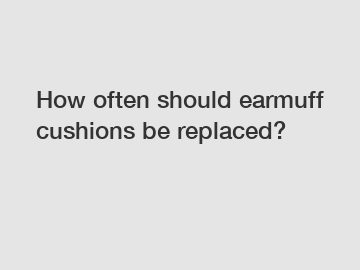Oct. 13, 2023
Sports & Entertainment
Welcome back, folks! Today we'll be diving into an important topic that often gets overlooked: replacing earmuff cushions. Whether you embrace a bustling workshop or savor peace at the shooting range, understanding when to replace your earmuff cushions is crucial for maintaining optimum hearing protection. In this blog, we'll explore the factors influencing earmuff cushion longevity and share expert tips to help you make informed decisions. So, grab a cup of coffee and let's jump right in!
1. The Importance of Earmuff Cushions:
The primary function of earmuff cushions is to create a seal around your ears, ensuring effective noise attenuation. These padded cushions absorb sound waves, protecting your hearing from potentially harmful levels of noise. Over time, however, due to regular wear and tear, earmuff cushions may lose their effectiveness, compromising your hearing protection.

2. Factors Influencing Cushion Lifespan:
Several factors determine the lifespan of earmuff cushions:
a) Frequency of use: If you frequently engage in activities with high noise exposure, such as shooting, heavy machinery operation, or live concerts, your earmuffs will undergo higher stress, demanding more frequent cushion replacements.
b) Environmental conditions: Extreme temperatures, humidity, and exposure to dirt, dust, or chemicals can accelerate cushion degradation. Assessing your working or recreational environment is crucial in determining cushion replacement intervals.
c) Material quality: The quality of the earmuff cushions also plays a significant role. High-quality materials tend to be more durable, providing extended lifespan and comfort. Lower-quality cushions may require more frequent replacements due to faster wear and tear.
3. Signs It's Time to Replace Earmuff Cushions:
Proactively identifying warning signs that earmuff cushions need replacement can significantly contribute to maintaining optimal hearing protection. Here are a few telltale signs to watch out for:
a) Visible wear and tear: Inspect the cushions regularly for cracks, tears, flattened shapes, or any signs of deterioration. Such damage hampers the cushion's ability to seal properly around the ears, leading to reduced noise reduction performance.
b) Decreased comfort: If your earmuffs feel less comfortable than before, it's a sign that the cushion material may have started to degrade. Discomfort may lead to poor earmuff positioning, compromising their performance.
c) Reduced noise reduction capabilities: Earmuffs come with a Noise Reduction Rating (NRR), defining their ability to attenuate sound. If you notice a significant decrease in the earmuff's effectiveness, it's time to replace the cushions.
4. Recommended Replacement Intervals:
While there is no one-size-fits-all answer to how often earmuff cushions should be replaced, certain guidelines can help you establish a routine. Generally, earmuff cushions should be replaced:
a) Annually: If you use your earmuffs regularly in moderate noise environments, replacing the cushions annually is a good practice to ensure optimal performance.
b) Semi-annually: For frequent users engaging in high-noise activities or working in challenging environments, replacing earmuff cushions every six months is recommended.
c) Use-based replacements: If you notice any signs of wear and tear, discomfort, or compromised noise reduction capabilities before the recommended timeframes, replace the cushions promptly.
5. DIY Maintenance Tips:
To prolong the lifespan of your earmuff cushions, there are some simple maintenance tips you can follow:
a) Regular cleaning: Wipe your earmuffs with a soft cloth to remove dirt and debris, ensuring the cushions remain clean. Remember to follow the manufacturer's guidelines for cleaning agents to avoid any potential damage.
b) Proper storage: Store your earmuffs in a clean, dry place to safeguard them from environmental factors that may accelerate cushion degradation.
c) Avoid excessive pressure: When not in use, avoid excessive pressure on the earmuffs, as it can deform the cushions, making them less effective.
Conclusion:
Protecting our hearing should always remain a top priority, and maintaining earmuffs in optimal condition plays a vital role in achieving this goal. By understanding the factors influencing earmuff cushion lifespan, recognizing warning signs, and following recommended replacement intervals, you can ensure your earmuffs provide the best possible noise attenuation. Remember, when it comes to preserving our hearing, a proactive approach is always the best approach.
Stay tuned for more informative content aimed at enhancing your overall safety and well-being. Until next time, stay safe and keep rocking those earmuffs!
For more information, please visit Western Safety Ear Muffs, Oem Hearing Protector, Best Hearing Protection for Babies.
Previous: Are Kidly Ear Defenders the Ultimate Solution for Kids with Sensory Overload?
Next: Mix Reality Games: Bridging the Gap Between Real and Virtual Worlds
If you are interested in sending in a Guest Blogger Submission,welcome to write for us!
All Comments ( 0 )